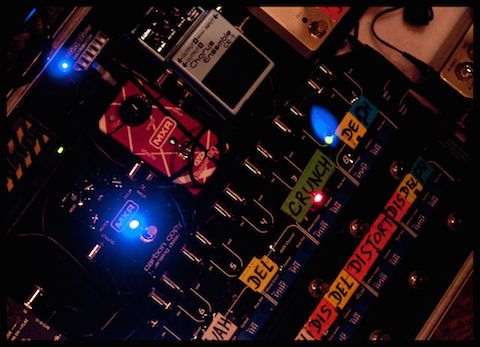
So, you have an electric guitar, a simple amp and a cable. You can play a few songs and riffs, maybe even solo a bit, but when you go to gigs, the guitarists all have loads of pedals and they sound great!
What are effects pedals?
Effects pedals are small ‘stomp’ boxes that go in your signal chain between the guitar and amp. You usually plug your guitar into the input of the pedal and then use another cable from the output of the pedal to the input of your amp. you stomp on the pedal with your foot to turn the effect on or off.
Common effects pedals include:
- Distortion/overdrive pedals
- Delay pedals
- Wah pedals
- Chorus pedals
- Flanger pedals
- Compressor pedals
- Reverb pedals
- Phaser pedals
- Loop pedals
Those are the most common pedal types, but there are many more. If you can afford it, you could go out and buy them all, but I wouldn’t recommend it!
Which Effects Pedals Should I Buy?
There is no point having more effects pedals than you know what to do with. A sensible approach would be to do a bit of research and see which effects your favourite guitarists use. Then buy one pedal and really get to know it.
Try all of the different settings on the pedal with different amp and guitar settings and see what you like. Write down any settings that sound great – for next time!
I play a lot of rock music and the one pedal that I could not do without is some kind of overdrive or distortion pedal.
What is the difference between overdrive and distortion?
Distortion and overdrive are similar, but are not the same. You can probably produce these sounds on your amp if it has a gain setting.
Start with a clean sound (low gain). Now turn the gain up a bit, the sound should start to break up a little and sound more ‘rock’. It probably got louder too? You may need to turn your volume or master control down a bit to compensate. You should be hearing overdrive now.
If you turn your gain control all the way up (turn the master or volume down a bit to compensate) then the sound will become much more saturated and ‘heavy’ sounding. This is distortion. Distortion is a more extreme version of overdrive, used commonly in metal and heavy rock.
If my amp can produce overdrive and distortion, why buy a pedal?
The main benefit of a pedal is that it is operated with your foot. You may be playing a song with lots of changes from clean to distortion, such as Smells Like Teen Spirit by Nirvana.
In order to switch between the clean and distorted sounds on your amp, you need to twiddle two knobs, but you also need your hands on the guitar! If you have a pedal then you can just step on it at the right moment to switch sounds.
It is worth mentioning at this point that there are other ways to switch from clean to overdriven or distorted sounds…
Tricks of the trade
Another, trickier way of switching between clean and dirty sounds uses your guitar volume knob. You will need to turn your guitar all the way up and find a nice dirty sound on the amp that you are happy with (or just turn it up really loud!).
If you now turn your guitar volume knob down, the sound should be cleaner without really losing any volume. If you want the dirty sound again, you just turn your guitar volume knob up!
This method is popular with professional players, but is not for everybody. The main drawback is that you have to take your right hand off of the guitar to operate your guitar volume knob, which takes a little time, depending on the guitar and the player…
Optional extras
If you have a multi channel amp, you may have the option to purchase a foot switch for it from the manufacturer. The foot switch will usually allow you to switch channels (i.e. from clean to distorted) or toggle other effects such as reverb etc on and off.
I would recommend getting the footswitch for your amp if there is one available. Not all amps have a foot switch capability. You can usually tell by looking on the back. If there is a 14″ jack input marked foot switch, or F/S, then you are in luck!
I control some of my amps via the manufacturer’s foot switch, and for others I use overdrive and distortion pedals.
What about the other effects pedals?
I realise that I have been banging on about overdrive and distortion for most of this article! What about the other effects pedals? Well… I’ll have to cover those in part two!
Please subscribe to my newsletter to be kept informed of my latest blog posts etc.
